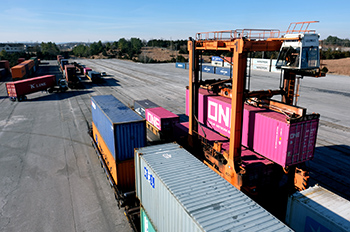Inland empire
Ports in Richmond, Front Royal receive upgrades
The Port of Virginia is investing in its two inland ports to boost capacity and maintain efficiency while handling greater volume from its Hampton Roads terminals.
A record 2.93 million 20-foot equivalent units, or TEUs, passed through the Port of Virginia system in 2019, a 3% increase over 2018.
“As we expand our primary terminals in the Norfolk Harbor and widen and deepen the channels to accommodate larger ships, our inland ports become critical,” says Port of Virginia spokesman Joe Harris. “We have to move that cargo into as many inland points as quickly as we can.”
The Virginia Inland Port, which is situated on 161 acres in Front Royal and connected by rail to the Norfolk and Portsmouth terminals, is scheduled to receive $26 million in upgrades.
Although the coronavirus has forced many industries to change plans, Harris says the projects at VIP and Richmond Marine Terminal are still on track. This spring, workers were still on site while maintaining social distancing recommendations by the state and the Centers for Disease Control and Prevention.
An $11 million cost-share project with the state will add three new railroad tracks at VIP later this year, bringing the total number of tracks on site to eight and lengthening existing tracks. The port also plans to purchase two straddle carriers to move cargo more efficiently. The port’s $3.3 million investment will be matched by a $7.7 million grant from the Virginia Railroad Enhancement Fund.

A second VIP building project is a bridge on Route 658 outside the terminal above existing tracks to improve traffic flow, funded by a $15.5 million federal grant awarded in December 2018.
“We’re in the final design phase of the VIP expansion right now and hope to start work this summer,” Harris says. The project is expected to be completed in about two years.
VIP is an important inland destination within the Port of Virginia system. The facility receives cargo via rail from Hampton Roads and transfers it onto tracks owned by CSX Corp., Norfolk Southern Corp. and smaller carriers to reach customers in the Northeast and Midwest.
Likewise, the Richmond Marine Terminal, the Virginia’s other inland port, is boosting capacity.
The port launched a second barge, the Virginia Express, last year to move more cargo along the James River between RMT and the Norfolk Harbor. A recent $1.8 million grant from the U.S. Department of Transportation will be used to expand the route, which is expected to reduce gridlock on Interstate 64.
Barge traffic within the port’s system was up more than 18% in 2019 over the previous year.
Both inland ports also serve as engines for their local economies.
Since VIP opened in 1989, nearly 40 companies have opened distribution centers in the Shenandoah Valley, including The Home Depot Inc., Kohl’s Corp., Rite Aid Corp. and Red Bull GmbH.
Shenandoah Valley rail connections also provide transport to major markets through Norfolk Southern CSX Corp., and through strong short-line railroads like Shenandoah Valley Railroad and Buckingham Branch Railroad.
InterChange Cold Storage opened a refrigerated warehousing facility in Rockingham County last fall, creating more than 100 new jobs. The facility, which supports the region’s growing food and beverage industry by storing products locally, totals about 230,000 square feet, with room on site to expand up to 600,000 square feet. The company also operates logistics centers in Front Royal, adjacent to VIP, and in Portsmouth, about nine miles from the port’s ocean terminals.
To increase efficiency, InterChange is looking to bring in a 2,800-foot rail spur off the Shenandoah Valley Railroad line to its Mount Crawford facility. The short-line railroad connects with a Norfolk Southern line about a mile north of the site, and with a CSX line in Staunton through another network. The $1.2 million rail spur project, which includes a $450,000 grant from the state and $150,000 from Rockingham County, is scheduled to be completed in August.
Connecting with two Class 1 railroads will allow better access to the Port of Virginia system, says Devon Anders, president of InterChange Group Inc. “At this point, we’re anticipating more inbound than outbound product from the rail spur,” he says, but longer term, the company wants to be able to help the region’s agricultural producers, including farmers specializing in poultry and other proteins, with export overseas.
Speculative development around the RMT has been a phenomenon in recent years, says Russell Held, vice president of economic development for the Port of Virginia.
In July, Amazon.com Inc. announced it will open a new fulfillment center in Richmond, creating 150 jobs. Virginia Secretary of Commerce and Trade Brian Ball says access to national and global markets through RMT and I-95 helped the city seal the deal with the online retail giant.
“The region has become a hub for the global logistics and distribution industry, providing businesses direct connectivity to customers on the East Coast,” Ball says.
l
















